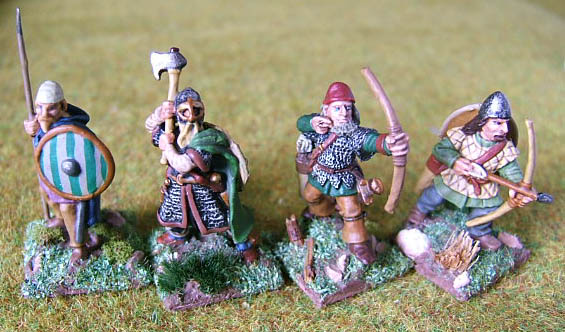I use thick card for the basic shape of the base. I glue the figure on with universal adhesive (Bostik, UHU etc.), and I make sure that I obey the instructions and put glue on both surfaces and wait a while before pressing them together, as this makes a much better join. I also coat the whole of the upper surface of the card with the adhesive, because this creates a seal that stops the card soaking up water from the texturing material, which might make it warp.
For the texture, I use something brown. I used to use white plaster, and paint it brown, but this takes longer, and if the result chips, you get a white bit showing through on your figure. I have used instead white powder plaster gap filler, bought from any hardware shop (get the cheapest, as it's near enough all the same), and mixed in poster paint. First, I put in a small blob of black paint, to counteract the whiteness of the powder, and then I add plenty of brown. One odd effect this has is that it increases the drying time for some reason, but if I've got a lot of bases to do, this is a welcome thing. I also usually add some PVA glue, to give the mix strength, stickiness, and water resistance when dry. More recently, I have been using brown acrylic mastic, squirted from a gun (see this page for information on mastic guns). This is the stuff sold for sealing windows and baths, and in some other countries it is called "caulking" or "silicone". Do not get silicon mastic, because this cannot be painted over - make sure that it is acrylic. This material has the advantage that you needn't mix a load of it for a job and then use it all before it dries. Instead, you could do just a couple of bases with it, if that's all you have time for, and the mastic will keep happily in its tube until you decide to do the next ones.
At the same time as I texture the base, hiding the base of the figure, I also paint the edge of the card with the same mud mix. Some people prefer a solid black line around their bases, but I much prefer the more realistic edges that you see here.
While the texturing material is still wet, I add stuff. For rocks, I use cat litter. Cat litter is made by smashing up large pieces into smaller ones, so it gives you a variety of rock-sizes, and they are angular and so look good in scale. Stones that have been weathered look too rounded in my opinion. I add the cat litter to the mastic with a wet paint brush, so that I can be sure that the surface of the mastic is wet when it receives the cat litter. This is important so that the mastic soaks into the cat litter to form a strong bond. If the mastic is not wetted in this manner, it very quickly forms a skin, which will stick to the cat litter, but when it dries the bond is a bit weak.
Small chunks of green-dyed foam (see the figure on the left in the picture) get stuck into the texturing material to represent little shrubs. Little bits of snapped twig get stuck in to represent logs and stumps (see the archer figure in the red cap, second from the right). Dry reeds are represented by sisal string (see the archer on the right). I hold the end of the string in the fingers of one hand, and snip it off with scissors held in the other, and then, pinching tightly, I transfer the snipped off short section to the wet mud mix on the base. Lush tufts of grass are made in the same way using green garden twine (see the axeman, second from the left).
When the base texture has dried, I add flock. I glue it on with PVA glue. There are "static" flocks of very fine fibrous material, and flocks that look more like dyed sawdust. I use a mix of the two. I leave a fair amount of the brown texturing material showing through. Make absolutely certain that any varnish on the figures has dried before gluing on flock, because you will be so annoyed if bits of stray flock stick to the figures.
If the undersides of the bases are ever going to be seen, I paint them brown with cheap paint and a big brush. In my skirmish games, I usually knock figures over when they die rather than remove them, and I hate to see the white squares of upturned bases, or, even worse, the designs of the beer mats from which they were cut. This doesn't take long, and it is worth going this extra inch, in my opinion.
BACK TO MODELLING MENU
Click here to go back to the home page



